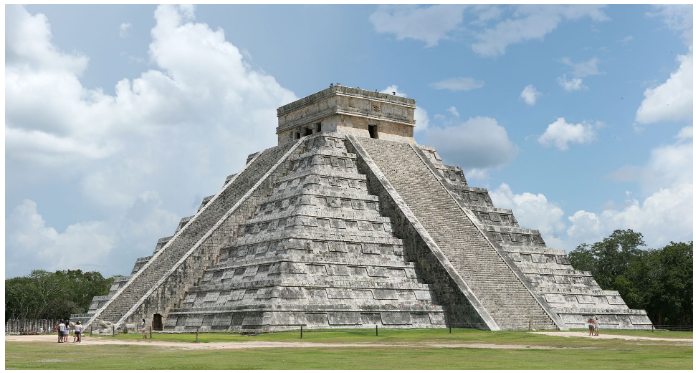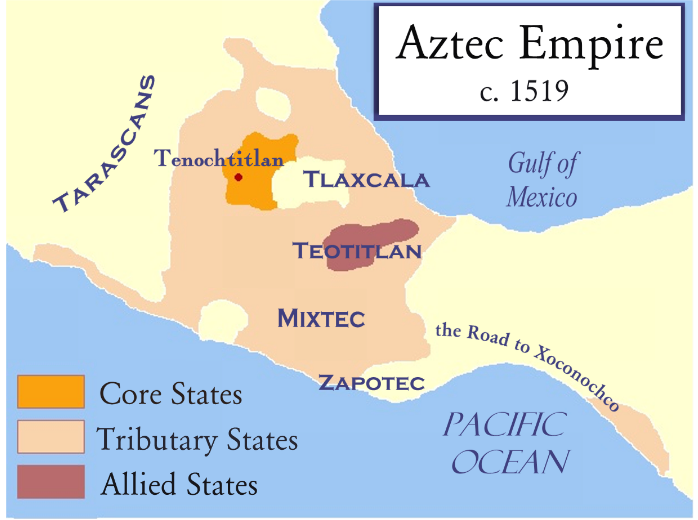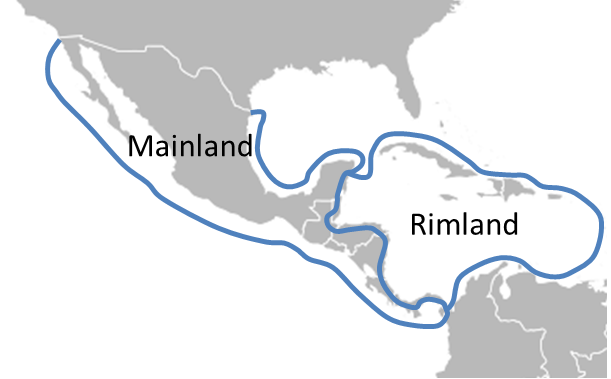5.2: Colonization and Conquest in Middle America
- Page ID
- 131892
Middle America was settled by a number of indigenous groups who originally migrated to the region from North America. Some continued on through the Isthmus of Panama to South America. Here, they founded the Mesoamerican cultural hearth, considered one of the earliest civilizations in the world. Two groups in the region had a particularly strong impact on the cultural landscape of Middle America: the Maya and the Aztec.
The Maya Civilization began around 2000 BCE and stretched across present-day Honduras, Guatemala, Belize, and the Yucatan peninsula. The civilization had a theocratic structure, with their king viewed as a divine ruler. They developed a system of hieroglyphic script, a calendar, a system of mathematics, and astronomy. The civilization had a number of city-states linked by a complex trading system. They also had monumental architecture. A number of their buildings, like the pyramidal Chichen Itza, are still visible on the landscape today (Figure \(\PageIndex{1}\)). At its height, the Maya Empire encompassed over one million people.

So what happened to the Maya? The short answer is: we’re not really sure. It takes a carefully managed infrastructure to care for one million people. Some researchers think the civilization simply got too big too fast. Any number of calamities, perhaps ecological damage or a disease epidemic, related to this rapid population growth could have had a devastating effect. Others think that infighting broke out within the society. Still, others maintain that historical climate data shows a decrease in rainfall in the region around the time of the Maya’s decline, perhaps indicating a widespread famine. In any case, in such a large society, it would only take a small problem to send the system into turmoil. By the 9th century CE, the Maya had abandoned its cities and its empire collapsed.
The Aztec Empire developed during the 15th century CE (Figure \(\PageIndex{2}\)). This civilization was centered around Tenochtitlan, which became its capital and one of the greatest cities in the Americas, with a population between 100,000 and 200,000 people. Today, the ruins of Tenochtitlan are located under present-day Mexico City. Aztec architecture, art, and trading systems were truly extraordinary for their time.

The Aztec empire was relatively short-lived, and the reason for its decline is much easier to pinpoint than the Maya. The Spanish, led by the conquistador Hernán Cortés, aligned themselves with a rival group and arrived in Tenochtitlan, as very unwelcome visitors, in 1520. Violence erupted and the Aztec leader Montezuma was killed, marking the beginning of the end of the civilization. By 1521, the Spanish and their allies had destroyed the city of Tenochtitlan and the Aztecs were subsequently ruled by a series of leaders who were chosen by the Spanish.
Colonization completely reshaped the Middle American landscape, from architecture to politics to land-holding patterns. Middle America can be divided into two different spheres, the mainland and the rimland, each with a distinct colonial history and experience (Figure \(\PageIndex{3}\)). Created through a fragmented realm of islands, the rimland was more accessible for European colonists than the mainland. The first explorers landed here when they reached the Americas. For example, Christopher Columbus reached the region in 1492 CE, and would land in South America on the third voyage in 1498 CE. The first Spanish cities in the Americas were established in the region during this time period. By the 1600s, England, Portugal, France, and the Netherlands were shipping Africans to the Americas to work on farms. Of the more than 11 million Africans who were sold as slaves and shipped overseas, over 90 percent were sent to the Caribbean and South America.

The rimland’s sprawling plantations where the slaves worked were focused on growing crops, most often sugar, for export. Prior to the commercial agriculture practiced on plantations, most in the region practiced subsistence farming, where farmers grow enough food to feed themselves and their families. Since subsistence farmers eat what they grow, they typically grow a variety of crops. You can only eat so much corn before you need a bit more variety. Plantation farms, however, were generally monocultures, meaning only a single crop was grown. Combined with the free slave labor, this action allowed for maximum efficiency and profit. Labor was seasonal, coinciding with the seasonality of the cultivated crop. Today, the rimland is still home to a number of plantations and the blending of European and African cultures is prominent on the landscape.
In the mainland, there is a blending of both indigenous and Spanish cultures. There is an ethnic blending as well. Mestizo refers to someone of mixed European and Amerindian, or indigenous American, descent. A number of Middle and South American countries have a sizable mestizo population. The Spanish conquest of mainland Middle America not only toppled the Aztec civilization but also led to the deaths of millions of indigenous people due to war and disease.
In contrast with the plantations of the rimland, the mainland was more commonly home to haciendas, Spanish estates where a variety of crops were grown both for local and international markets. As a result, workers lived on the land, unlike the seasonal laborers needed to work plantations. Although haciendas were less efficient than plantations, they were also less vulnerable economically. If you’re only growing one crop and the price of that crop declines, you have no backup. Similarly, disease or a bad harvest could dramatically decrease profits. The increased diversity in crops grown on a hacienda decreased risk. Haciendas also had an element of social prestige. The size of the hacienda increased the social standing of the landowner, and hacienda farmers were often given their own plots of land to cultivate.
Broadly, the colonization of Middle America led to land alienation, where land is taken from one group and claimed by another. Where indigenous groups might have previously controlled their own subsistence farms, wealthy European settlers took over the land and built haciendas – often then employing those whose land they claimed. Today, poverty continues to be a significant issue among the indigenous people of Middle and South America and the current system of land ownership found in the region directly connects to European colonization.
- Plantations:
-
an agricultural system designed to produce one or two crops primarily for export
- Subsistence farming:
-
where farmers grow food primarily to feed themselves and their families.
- Mestizo:
-
a term referring to someone of mixed European and Amerindian descent
- Haciendas:
-
a Spanish estate where a variety of crops are grown both for local and international markets
- Land alienation:
-
when land is taken from one group and claimed by another

